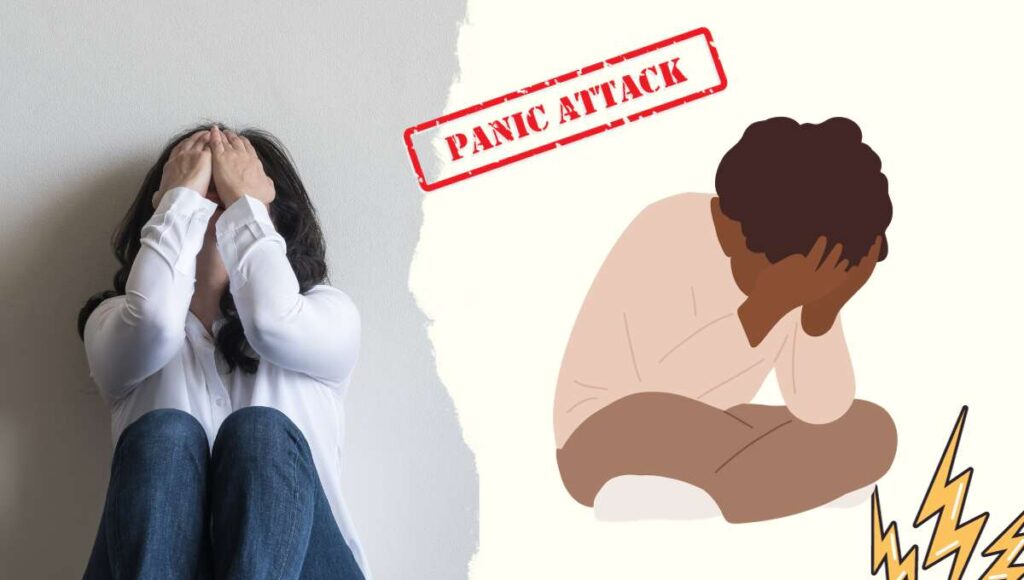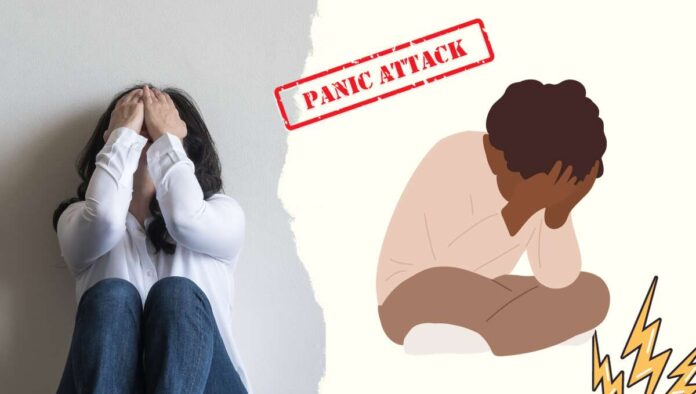Panic attacks and anxiety attacks: understand, recognize, and control
Today’s fast lifestyle and stressful environment have made panic attacks and anxiety attacks a common condition. In this article, we will discuss the differences between these two attacks—panic attacks and anxiety attacks—and look at various measures to properly identify and control them.
Panic Attack and Anxiety Attack: Understanding the Difference
It is important to understand the difference between a panic attack and an anxiety attack. A panic attack occurs suddenly and rapidly, causing a person to feel terrible fear and physical discomfort similar to a thunderstorm, while an anxiety attack develops gradually and gives a feeling of worry and anxiety.

These are panic disorder and generalized anxiety disorder (GAD), which are two separate but related conditions that are classified under the broader category of anxiety disorders.Here are the main differences between panic disorder and generalized anxiety disorder:
Anxiety problem:
Nature of Attacks:
Panic Attacks: The key feature of panic disorder is the occurrence of panic attacks. These are sudden and intense episodes of fear or anxiety that reach a peak within a few minutes. Physical symptoms such as a racing heartbeat, sweating, trembling, and a feeling of impending doom are all common during a panic attack. Frequency and Unpredictability:
Panic attacks often occur unexpectedly and are not necessarily linked to specific circumstances.A person who suffers from panic disorder may worry about the possibility of another attack, leading to increased anxiety and avoidance behavior. Pay attention to physical symptoms.
People with panic disorder focus more on the physical symptoms of anxiety and may fear that they are experiencing a life-threatening medical condition during a panic attack. Generalized Anxiety Disorder (GAD).
Long-Term Concern:
GAD is characterized by persistent and excessive worry about various everyday concerns, such as work, health, family, or finances. The worry is often unrealistic or out of proportion to the actual situation. Physical symptoms and psychological distress.
While individuals with GAD may experience physical symptoms of anxiety (e.g., muscle tension, restlessness, fatigue), the main characteristic is the chronic nature of the anxiety and associated psychological distress. Absence of acute panic attacks.
Unlike panic disorder, GAD does not usually involve sudden, intense panic attacks. Instead, the anxiety in GAD is more diffuse, longer-lasting, and not necessarily linked to any specific trigger. Difficulty controlling anxiety.
Individuals with GAD often find it challenging to control their anxiety, and the anxiety interferes with their daily functioning. They might exhibit signs including agitation, trouble focusing, and tense muscles.
It is important to note that although panic disorder and GAD have distinct characteristics, they may co-exist in some individuals. Additionally, other anxiety disorders may share overlapping symptoms.
A good and accurate diagnosis and a treatment plan require a comprehensive examination by a mental health professional that is appropriate and specific to the individual’s needs. and be well.
Symptoms of panic attacks and anxiety attacks:
Panic attacks and anxiety attacks have some common symptoms. Which have some different characteristics.
Fast heartbeat (palpitations):
- The heart may pound or race, and individuals may feel as if they are having a heart attack.
Difficulty breathing:
- Difficulty breathing or feeling suffocated is a common symptom.
Chest pain or discomfort:
- Some people may experience chest pain or discomfort, which may lead to a fear of a cardiac event.
Shaking or trembling:
- Physical symptoms often include shaking or shivering.
Sweating:
- Excessive sweating, even if the environment is not hot, is a common reaction.
Chills or hot flashes:
- A sudden feeling of chills or hot flashes may occur.
Feeling detached or unreal:
- A feeling of unreality or detachment from the self, known as depersonalization, may occur.
Fear of losing control or going crazy:
- During a panic attack, individuals may fear losing control or going crazy.
Symptoms of anxiety attacks (generalized anxiety):
- Excessive worry: persistent and excessive worry about various aspects of life, often beyond the situation.
- Restlessness: feeling on edge, restless, or off.
- Muscle tension: stiffness in the muscles, causing physical discomfort.
- Fatigue: feeling tired easily even without engaging in physically demanding activities.
- Difficulty concentrating: having trouble concentrating or feeling like the mind has gone blank.
- Irritability: increased irritability or a feeling of being on edge.
- Sleep disturbances: difficulty falling asleep, staying asleep, or experiencing restless and unsatisfactory sleep.
- Physical symptoms: Symptoms such as headaches, stomach aches, and other physical discomfort may be present.
Additionally, both panic attacks and anxiety attacks can be debilitating. Which can affect a person’s daily life and many functions.
If one is experiencing these symptoms, it is advisable to seek professional help from a healthcare provider or mental health professional for an accurate diagnosis and appropriate treatment.
Panic attacks and anxiety attacks:
Keep under control or treatment
Finally, we will focus on some easy and effective ways to control. Panic attacks and anxiety attacks These techniques can help you in your everyday life and help you move in a positive direction.
Here are some important techniques that may help in controlling these attacks. Deep Breathing. Make sure to breathe slowly and deeply. Breathe in deeply with your nose, hold it for a short while, and then gently release the breath through your mouth.
Mindfulness Meditation:
- Engage in mindfulness or meditation practices. You may achieve anxiety reduction by focusing on what you’re thinking and being in the present moment.
Progressive Muscle Relaxation (PMR):
- Systematically tense and then relax different muscle groups in your body. This helps discharge actual pressure related to tension.
Grounding Techniques:
- Use grounding techniques to stay connected to the present. Focus on your sensory nerve by describing what you see, hear, feel, and smell around you.
Positive Affirmations:
- Develop positive affirmations or coping statements. Repeat these phrases to yourself during moments of stress to counter negative thoughts.
Cognitive Behavioral Therapy (CBT):
- Consider CBT, a therapeutic approach that helps identify and challenge negative thought patterns.
Regular Exercise:
- Get moving on a regular basis. It has been demonstrated that physical activity improves mental states all around and minimizes anxiety disorders.
Develop a Schedule:
- Plan out and carry out a daily schedule. Uncertainty and anxiety can be lessened by structure and predictability.
Limit Caffeine and Sugar:
- Reduce intake of stimulants like caffeine and excessive sugar, as they can contribute to feelings of restlessness and anxiety.
Seek Professional Help:
- Consult with a mental health professional for personalized guidance and support. Therapy or counseling can provide effective coping strategies.
It’s important to note that if you’re struggling with these attacks, consider consulting with a mental health professional for tailored advice and support.
Conclusion
Through this post, we have understood panic attacks and anxiety attacks, learned how to properly recognize their symptoms, and introduced some measures to control them. If you or someone you know has such problems, please consult a good doctor to control them properly.
Here are frequently asked questions related to panic attacks and anxiety attacks.
How do you understand panic attacks and anxiety?
Understanding these attacks involves the process of recognizing their symptoms and understanding their causes. A panic attack is a sudden and intense state of fear, accompanied by physical symptoms as well as a feeling of mental insecurity. Anxiety is a more long-term condition that can cause worry, disinhibition, and anxiety, which can affect the daily routine.
How do I control panic attacks alone?
Controlling panic attacks alone involves practicing self-help techniques. Deep breathing exercises, progressive muscle relaxation, and mindfulness techniques can help manage physical symptoms. Identifying and confronting negative thoughts, using positive affirmations, and creating a peaceful environment are also effective. It is advisable to consult a doctor to handle panic attacks from a holistic perspective.
Would you manage with panic attacks and anxiety?
Dealing with it requires a multifaceted approach. The first thing is to identify the triggers and learn the opposites that arise. Practicing stress reduction techniques, following regular exercise and a balanced diet, and ensuring adequate sleep can be helpful for general health. Seeking support from friends, family, or mental health professionals can be extremely helpful in facing these challenges.
How do you understand and control anxiety?
Understanding and controlling anxiety requires self-awareness and targeted techniques. Recognizing the signs of anxiety, such as excessive worrying, restlessness, and difficulty concentrating, is the first step. Developing healthy coping techniques, such as regular exercise, mindfulness practices, and relaxation techniques, can help control anxiety. Additionally, creating a structured routine, setting doable goals, and seeking professional support are important parts of a positive anxiety management plan.





[…] it comes to managing or preventing anxiety and panic attacks, a personalized touch can make a huge difference. Harness the therapeutic power of essential oils […]
[…] anxiety is defined as a distinct feeling of intense distress and panic that you face when separation from your romantic partner occurs, is likely, or is imminent. . This […]
[…] Panic attacks. […]
[…] Panic is an intense feeling of fear or apprehension that arises suddenly, often accompanied by physical symptoms such as rapid heartbeat, shortness of breath, and trembling. Panic attacks can be debilitating and disruptive to daily life. […]